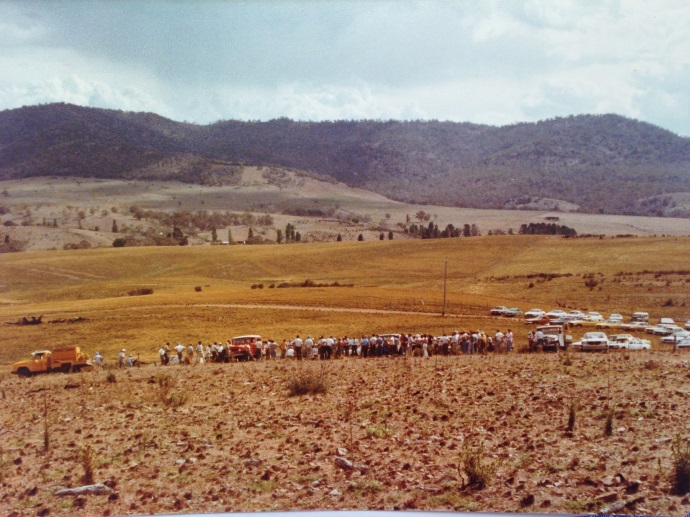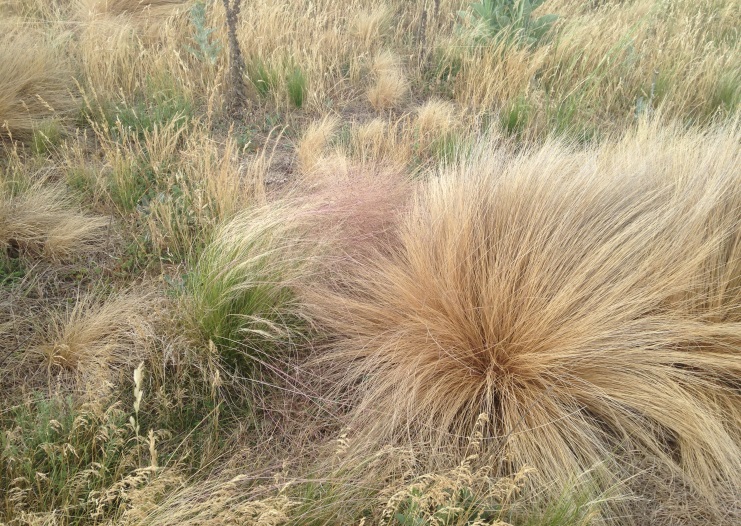Flupropanate resistant serrated tussock on the Monaro
Background
Serrated tussock (Nassella trichotoma) was thought to have been introduced into Australia in the early 1900s and is reportedly now distributed over more than 860,000 hectares of NSW in mainly tableland areas including the Monaro region (Victorian DPI 2008).
Minimal herbicide options have been available for the control of serrated tussock since its identification, with flupropanate (e.g. Taskforce) and glyphosate (e.g. Roundup) being the most commonly used in control activities.
The continual use of group J herbicides (eg/ flupropanate) for more than 15-20 years has resulted in the development of herbicide resistant serrated tussock biotypes (McLaren et al. 2008). Resistant populations have been previously reported in both Victoria and New South Wales.
Local archived reports indicate that NSW DPI commenced serrated tussock control trials using flupropanate back in the mid-1980s in the Dalgety region. This herbicide remains in common use today across the Monaro so the region has certainly crossed the 15-20 year threshold for herbicide resistant biotypes (sub-populations) to evolve.
Jointly funded through South East Local Land Services, Snowy Monaro Regional Council and the Australian Government’s National Landcare Programme, a multi-year serrated tussock herbicide resistance testing project commenced in mid-2016.
Year One Testing
In mid-December 2016, 13 samples of serrated tussock seed were collected across the Monaro region. This seed was then sent to Plant Science

Figure 1. A NSW DPI Serrated Tussock field day at Werralong Road in the early-1980s (archive image)
Consulting (South Australia) then germinated with the seedlings sprayed with flupropanate (Taskforce) at the rates of 1.25, 2 and 3L/ha.
Assessment of the effectiveness of herbicide control was made 9 weeks after treatment. Note: Seedlings were actively growing stress-free young plants so any plant resistant flupropanate will be displayed in a short period of time.
Results
Five of the thirteen samples were found to have a high level of resistance to the herbicide flupropanate. Increasing the rate of application of flupropanate from 1.25 to 2 and 3 L/ha did not improve the control of these resistant biotypes which confirms the high-level of resistance.
In the Bredbo region, one of three sites sampled were identified as resistant to flupropanate. Four of the five sites tested along Bulgundra and Werralong Roads (near Dalgety) were also found to be resistant to the herbicide. It is worth noting that whilst flupropanate resistant biotypes were confirmed at both of these localities, susceptible populations were also recorded.
Samples from the Bombala region were all found to be susceptible to flupropanate (no resistance identified) as was the one sample from a Nimmitabel location.

Figure 2. One of the sample locations near Dalgety. Whilst many of the surrounding plants had been controlled, several serrated tussock plants had survived previous treatment and were reproducing (Photo: Jo Powells).
Implications for control of serrated tussock on the Monaro
The confirmation of flupropanate resistant serrated tussock biotypes in the region is a reminder to all landholders of the importance of adopting an integrated approach to managing serrated tussock.
Landholders are encouraged to:
- Use immediate acting or short residual herbicides wherever possible. Use long term residual herbicides (flupropanate) wisely and not continuously on the same parcel of land.
- Always apply herbicides according to label directions. And keep good spray records for every paddock.
- Regularly rotate herbicide types used with different modes of action.
- Do not rely solely on the use of chemicals for control.
- If using herbicides, ongoing monitoring of paddocks post-application is required to identify plants that may have survived the treatment.
- Report suspected herbicide resistance to your local weeds officer or agronomist.
- Undertake herbicide resistance testing to confirm any resistance issues.
In conjunction with Snowy Monaro Regional Council, South East Local Land Services are currently planning the second year of herbicide resistance testing for the Monaro which will include further testing and a strategic approach to identifying areas with herbicide resistance. Further information about this will be publicised in the coming month.
Advice for Serrated Tussock Control Spring 2017
- Be alert, not alarmed!
- Land managers are encouraged to be on the lookout for possible serrated tussock resistance plants/ populations.
- If using flupropanate this spring, monitor paddock closely over the next 12 months.
- Chip out surviving plants (if possible) or treat survivors with glyphosate (don’t reapply flupropanate).
- Report any resistance concerns to the local council vegetation officers or South East LLS (Cooma Office).
- If one is not already in place, start developing an Integrated Weed Management Plan. Advice on how to do this can be found at: http://southeast.lls.nsw.gov.au/__data/assets/pdf_file/0011/685460/integrated-weed-management-plan-guide.pdf.
- Become familiar with the NSW DPI Primefact “Recognising, managing and preventing herbicide resistance in serrated tussock”.
- Get tested. Herbicide resistance testing is the best way to confirm the presence or absence of resistance in a controlled environment that removes variables such as climate, soil type and spray operator error. Monaro landholders may be able to access subsidised resistance testing this spring.
- Contact the Cooma office for further information on (02) 6452 1455.